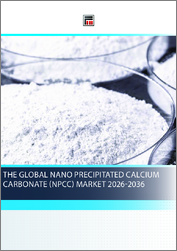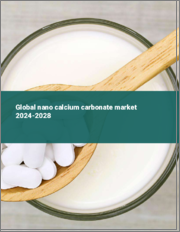
|
시장보고서
상품코드
1808074
세계의 NPCC(Nano Precipitated Calcium Carbonate) 시장(2026-2036년)The Global Nano Precipitated Calcium Carbonate (NPCC) Market 2026-2036 |
||||||
세계 NPCC(Nano Precipitated Calcium Carbonate) 시장은 광범위한 탄산칼슘 산업에서 뛰어난 성능 특성을 특징으로 하며, 기존 대체품보다 훨씬 더 높은 가격의 고급 특수 부문입니다. 입자 크기가 10-200 나노미터인 NPCC는 극적으로 강화된 표면적, 우수한 계면 상호작용, 다양한 고부가가치 용도에서 고급스러운 포지셔닝을 정당화할 수 있는 다기능성을 제공합니다.
바이오의약품은 생체이용률 강화 요건과 규제 준수 기준으로 인해 시장을 독식하고 있습니다. 이 부문은 고령화, 제네릭 의약품의 개발, 방출 제어 제제에 대한 수요로 인해 강력한 성장세를 보이고 있습니다. 고급 페인트 및 코팅은 NPCC의 우수한 불투명도와 성능을 유지하면서 고가의 산화티타늄을 부분적으로 대체할 수 있는 능력의 혜택을 누리고 있습니다. 특수 플라스틱 첨가제는 주로 강화된 기계적 특성과 치수 안정성이 요구되는 자동차의 프리미엄 부문에 적용되고 있습니다.
주요 성장 촉진요인은 고성능 소재에 대한 수요 증가, 의약품의 생체 이용률 향상 요구 사항, 자동차 경량화 계획 등입니다. 그러나 시장 확대는 높은 생산 비용, 기술적 응용 장벽, 대체 재료와의 경쟁 등의 제약 요인에 직면해 있습니다. 시장은 기존 대체 재료에 대한 비용 경쟁력, 제한된 규모의 경제, 전문적인 응용 개발을 필요로 하는 기술적 복잡성 등 큰 문제에 직면해 있습니다.
세계의 NPCC(Nano Precipitated Calcium Carbonate) 시장에 대해 조사분석했으며, 2026-2036년의 시장 역학, 기술개발, 경쟁 구도, 지역의 성장 기회에 관한 상세 인사이트를 제공하고 있습니다.
목차
제1장 서론과 개요
제2장 기술과 특성 분석
- 제조 기술
- 침강 방법과 프로세스
- 탄산화 프로세스 기술
- 표면 개질 기술
- 품질관리와 시험 방법
- 물리적/화학적 성질
- 성능 특성
- 강화 특성
- 배리어 특성
- 광학적 강화
- 처리상 이점
제3장 비교 분석 : NPCC와 기존 대체품
- NPCC와 경질질산칼슘(PCC)
- 입자 사이즈 비교
- 표면적 차이
- NPCC의 성능상 이점
- 비용편익 분석
- 특정 용도 비교
- NPCC와 중질탄산칼슘(GCC)
- 처리 방법의 차이
- 품질과 일관성 비교
- 성능상 이점
- 경제적 고려
- NPCC와 기타 나노 필러
- 나노 실리카와의 비교
- 나노클레이와의 비교
- 탄소나노튜브와의 비교
- 경쟁상 포지셔닝
- 이점과 한계
- NPCC의 기술적 이점
- 경제적 이익
- 환경에 대한 영향
- 현재의 한계와 과제
제4장 용도와 최종 용도 시장
- 플라스틱·폴리머
- 필름·포장
- 자동차용 플라스틱
- 건축자재
- 고무
- 페인트·코팅
- 건축용 코팅
- 자동차용 코팅
- 산업용 코팅
- 특수 코팅
- 종이·펄프
- 종이 충전 용도
- 코팅 용도
- 인쇄 품질 향상
- 비용 삭감
- 접착제·실란트
- 구조용 접착제
- 실란트 용도
- 퍼스널케어·화장품
- 스킨케어 제품
- 색조 화장품
- 구강관리 제품
- 규제상 고려 사항
- 의약품
- 영양보충제
- 정제
- 약물전달 시스템
- 부형제 용도
- 식품 및 음료
- 식품첨가제 용도
- 가공조제
- 규제 구조
- 첨단 복합재료
제5장 시장 수요 분석
- 세계 시장 규모와 성장
- 시장 규모(2019-2024년)
- 현재 시장 규모(2024년)
- 향후 예측(2025-2036년)
- 시장 수요 : 용도 부문별
- 성장 촉진요인 : 부문별
제6장 지역 시장 분석
- 북미
- 유럽
- 아시아태평양
- 라틴아메리카
- 중동
- 남아프리카공화국
제7장 생산과 공급망 분석
- 세계의 생산능력
- 현재 생산량과 가동률
- 생산 성장 동향과 생산능력 개발
- 제조 경제성과 비용 구조
- 생산비용 분석 : 지역별
- 공급망 역학
- 제조 효율과 규모의 경제
- 향후 생산 전망
제8장 가격 분석
- 세계의 평균 가격
- 가격결정 : 등급별
- 주요 가격결정 요인
- 원재료 비용의 영향
- 수급 역학
- 단기적인 가격 전망
- 장기적인 가격 예측
- 가격 감응도
제9장 시장 촉진요인과 과제
- 성장 촉진요인
- 고성능 재료의 수요 증가
- 지속가능성과 환경상 혜택
- 기술의 진보
- 용도의 확대
- 비용 퍼포먼스의 최적화
- 시장이 해결해야 할 과제
- 높은 생산비용
- 기술적 응용 장벽
- 대체품과의 경쟁
- 경제변동의 영향
- 공급망 혼란
제10장 상업용 모델
- 가격 전략
- 유통 채널
- 고객 획득 어프로치
제11장 기업 개요(기업 30사의 개요)
제12장 부록
제13장 참고 문헌
KSA 25.09.16The global nano precipitated calcium carbonate (NPCC) market represents a premium specialty segment within the broader calcium carbonate industry, characterized by exceptional performance properties and commanding significant price premiums over conventional alternatives. With particle sizes ranging from 10-200 nanometers, NPCC offers dramatically enhanced surface area, superior interfacial interactions, and multifunctional capabilities that justify its premium positioning across diverse high-value applications.
Pharmaceuticals dominate the market due to bioavailability enhancement requirements and regulatory compliance standards. This segment demonstrates robust growth driven by aging demographics, generic drug development, and controlled-release formulation needs. Premium paints and coatings benefit from NPCC's superior opacity characteristics and ability to partially replace expensive TiO2 while maintaining performance. Specialty plastic additives primarily find application in automotive premium segments requiring enhanced mechanical properties and dimensional stability.
Key growth drivers include increasing demand for high-performance materials, pharmaceutical bioavailability enhancement requirements, and automotive lightweighting initiatives. However, market expansion faces constraints from high production costs, technical application barriers, and competition from alternative materials. The market confronts significant challenges including cost competitiveness versus conventional alternatives, limited economies of scale, and technical complexity requiring specialized application development.
"The Global Nano Precipitated Calcium Carbonate Market 2026-2036" provides detailed insights into market dynamics, technological developments, competitive landscape, and regional growth opportunities spanning 2026-2036.
Report contents include:
- Technology and Manufacturing Landscape:
- Advanced precipitation methods and carbonation process technologies
- Surface modification techniques for enhanced performance characteristics
- Quality control and testing methodologies ensuring product consistency
- Manufacturing cost structure analysis across major production regions
- Supply chain dynamics and capacity utilization optimization strategies
- Performance Characteristics and Applications:
- Reinforcement properties delivering superior mechanical enhancement
- Barrier properties for improved moisture and gas resistance
- Optical enhancement capabilities for coatings and specialty applications
- Processing advantages enabling manufacturing efficiency improvements
- Comparative analysis against conventional calcium carbonate alternatives
- Plastics and Polymers Applications:
- Film and packaging solutions with enhanced barrier properties
- Automotive plastics requiring superior mechanical performance
- Specialty polymer applications demanding precise particle characteristics
- Pharmaceutical and Healthcare Markets:
- Nutritional supplements with improved bioavailability profiles
- Tablet formulations requiring controlled release characteristics
- Drug delivery systems leveraging nanoscale particle advantages
- Excipient applications supporting pharmaceutical manufacturing
- Coatings and Surface Treatment Applications:
- Architectural coatings with enhanced opacity and durability
- Automotive coatings requiring premium finish characteristics
- Industrial coatings for demanding environmental conditions
- Specialty coatings for niche high-performance applications
- Personal Care and Cosmetics Markets:
- Skincare products requiring gentle, effective formulations
- Colour cosmetics demanding superior coverage and aesthetic properties
- Oral care products with enhanced cleaning capabilities
- Regulatory considerations for consumer safety compliance
- Industrial and Specialty Applications:
- Paper and pulp applications for print quality enhancement
- Adhesives and sealants requiring superior bonding performance
- Food and beverage processing aid applications
- Construction materials demanding enhanced durability
- Rubber applications requiring improved mechanical properties
- Regional Market Dynamics
- Pricing Analysis and Market Dynamics
- Global average pricing analysis by application and region
- Grade-specific pricing reflecting quality and performance requirements
- Raw material cost impact on manufacturing economics
- Supply-demand dynamics influencing pricing strategies
- Long-term price projections supporting investment decisions
- Technology Advancement Drivers:
- Increasing demand for high-performance materials across industries
- Sustainability and environmental benefits supporting adoption
- Technological innovations enabling new application development
- Cost-performance optimization creating competitive advantages
- Market Challenges and Constraints:
- High production costs limiting broader market penetration
- Technical application barriers requiring specialized expertise
- Competition from alternative nanomaterials and conventional fillers
- Economic volatility affecting industrial demand patterns
- Supply chain disruptions impacting manufacturing operations
- Commercial Models and Distribution Strategies
- Company Landscape and Competitive Analysis. The global NPCC market features a diverse competitive landscape with established chemical companies and specialized nanomaterial producers. Key companies profiled include: Changzhou Calcium Carbonate Co., Ltd., Chun Shin Chemical, Diamond Quantum (DIACAL), EMV Nanomaterials, Fimatec Ltd., Foshan Xintu Chemical Co., Ltd., FP-Pigments and more.......
TABLE OF CONTENTS
1. INTRODUCTION AND OVERVIEW
- 1.1. Definition and Classification
- 1.2. Classification by Particle Size and Morphology
2. TECHNOLOGY AND PROPERTIES ANALYSIS
- 2.1. Manufacturing Technologies
- 2.1.1. Precipitation Methods and Processes
- 2.1.2. Carbonation Process Technology
- 2.1.3. Surface Modification Techniques
- 2.1.4. Quality Control and Testing Methods
- 2.2. Physical and Chemical Properties
- 2.3. Performance Characteristics
- 2.3.1. Reinforcement Properties
- 2.3.2. Barrier Properties
- 2.3.3. Optical Enhancement
- 2.3.4. Processing Advantages
3. COMPARATIVE ANALYSIS: NPCC vs. CONVENTIONAL ALTERNATIVES
- 3.1. NPCC vs. Precipitated Calcium Carbonate (PCC)
- 3.1.1. Particle Size Comparison
- 3.1.2. Surface Area Differences
- 3.1.3. Performance Advantages of NPCC
- 3.1.4. Cost-Benefit Analysis
- 3.1.5. Application-Specific Comparisons
- 3.2. NPCC vs. Ground Calcium Carbonate (GCC)
- 3.2.1. Processing Method Differences
- 3.2.2. Quality and Consistency Comparison
- 3.2.3. Performance Benefits
- 3.2.4. Economic Considerations
- 3.3. NPCC vs. Other Nano-Fillers
- 3.3.1. Comparison with Nano-Silica
- 3.3.2. Comparison with Nano-Clay
- 3.3.3. Comparison with Carbon Nanotubes
- 3.3.4. Competitive Positioning
- 3.4. Advantages and Limitations
- 3.4.1. Technical Advantages of NPCC
- 3.4.2. Economic Benefits
- 3.5. Environmental Impact
- 3.6. Current Limitations and Challenges
4. APPLICATIONS AND END-USE MARKETS
- 4.1. Plastics and Polymers
- 4.1.1. Film and Packaging
- 4.1.2. Automotive Plastics
- 4.2. Construction Materials
- 4.3. Rubber
- 4.4. Paints and Coatings
- 4.4.1. Architectural Coatings
- 4.4.2. Automotive Coatings
- 4.4.3. Industrial Coatings
- 4.4.4. Specialty Coatings
- 4.5. Paper and Pulp
- 4.5.1. Paper Filling Applications
- 4.5.2. Coating Applications
- 4.5.3. Print Quality Enhancement
- 4.5.4. Cost reduction
- 4.6. Adhesives and Sealants
- 4.6.1. Structural Adhesives
- 4.6.2. Sealant Applications
- 4.7. Personal Care and Cosmetics
- 4.7.1. Skincare Products
- 4.7.2. Colour Cosmetics
- 4.7.3. Oral Care Products
- 4.7.4. Regulatory Considerations
- 4.8. Pharmaceuticals
- 4.8.1. Nutritional Supplements
- 4.8.2. Tablet Formulations
- 4.8.3. Drug Delivery Systems
- 4.8.4. Excipient Applications
- 4.9. Food and Beverages
- 4.9.1. Food Additive Applications
- 4.9.2. Processing Aids
- 4.9.3. Regulatory Framework
- 4.10. Advanced Composites
5. MARKET DEMAND ANALYSIS
- 5.1. Global Market Size and Growth
- 5.2. Historical Market Size (2019-2024)
- 5.3. Current Market Size (2024)
- 5.4. Future Projections (2025-2036)
- 5.5. Market Demand by Application Segment
- 5.6. Growth Drivers by Segment
6. REGIONAL MARKET ANALYSIS
- 6.1. North America
- 6.2. Europe
- 6.3. Asia-Pacific
- 6.4. Latin America
- 6.5. Middle East
- 6.6. South Africa
7. PRODUCTION AND SUPPLY CHAIN ANALYSIS
- 7.1. Global Production Capacity
- 7.1.1. Current Production Volumes and Capacity Utilization Rates
- 7.1.2. Production Growth Trends and Capacity Development
- 7.2. Manufacturing Economics and Cost Structure
- 7.2.1. Production Cost Analysis by Region
- 7.3. Supply Chain Dynamics
- 7.4. Manufacturing Efficiency and Scale Economics
- 7.5. Future Production Outlook
8. PRICING ANALYSIS
- 8.1. Global Average Prices
- 8.2. Grade-Specific Pricing
- 8.3. Key Pricing Factors
- 8.4. Raw Material Cost Impact
- 8.5. Supply-Demand Dynamics
- 8.6. Short-Term Price Outlook
- 8.7. Long-Term Price Projections
- 8.8. Price Sensitivity
9. MARKET DRIVERS AND CHALLENGES
- 9.1. Growth Drivers
- 9.1.1. Increasing Demand for High-Performance Materials
- 9.1.2. Sustainability and Environmental Benefits
- 9.1.3. Technological Advancements
- 9.1.4. Expanding Application Areas
- 9.1.5. Cost-Performance Optimization
- 9.2. Market Challenges
- 9.2.1. High Production Costs
- 9.2.2. Technical Application Barriers
- 9.2.3. Competition from Alternatives
- 9.2.4. Economic Volatility Impact
- 9.2.5. Supply Chain Disruptions
10. COMMERCIAL MODELS
- 10.1. Pricing Strategies
- 10.2. Distribution Channels
- 10.3. Customer Acquisition Approaches
11. COMPANY PROFILES (30 company profiles)
12. APPENDIX
- 12.1. Research Methodology
















